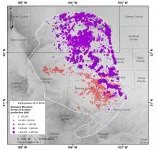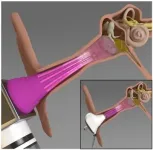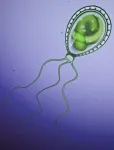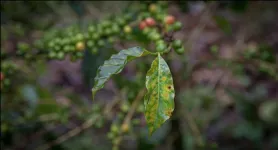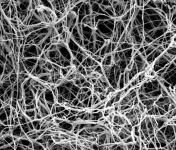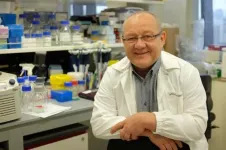Pop-up coffee table -- no assembly required
Kiriform structures harness buckling for stable, deployable structures
2021-06-28
(Press-News.org) Deployable structures -- objects that transition from a compact state to an expanded one -- are used everywhere from backyards to Mars. But as anyone who has ever struggled to open an uncooperative folding chair knows, transforming two-dimensional forms into three-dimensional structures is sometimes a challenge.
Now, researchers from the Harvard John A. Paulson School of Engineering and Applied Sciences (SEAS) and the Harvard Graduate School of Design have developed a deployable system that is light, compact, inexpensive, easy to manufacture, and, most importantly, easy to deploy. By harnessing the mechanical instabilities in curved beams, the system can transform objects into elaborate and customizable 3D configurations on a range of scales, from large-scale furniture to small medical devices.
"Most buckling-induced deployable structures, like folding chairs, are activated by compressive forces that are created through the linear displacement of elements," said Saurabh Mhatre, a research associate at GSD and first author of the paper. "Our approach is different in that the compression force is generated through a rotational movement, which in turn induces buckling as the trigger for the 2D-to-3D transformation."
The interdisciplinary research team of designers and engineers used a combination of experiments and numerical analyses to understand the geometry of curved, slender beams and what happens when those beams rotate and buckle. By harnessing buckling - a normally undesirable phenomenon in design and engineering -- the researchers were able to design deployable structures with a simple rotational motion.
To demonstrate the system, the team built a lampshade that can be rotated to let in more or less light and a coffee table that can fold flat and pop-up in one simple motion.
"This new platform can be extended to realize functional structures and devices from the millimeter to meter scale using a variety of different materials," said Katia Bertoldi, the William and Ami Kuan Danoff Professor of Applied Mechanics at SEAS and senior author of the study. "These structures could be used as medical devices, optical devices like camera focusing mechanisms, deployable wheels and turbines, furniture, or deployable shelters."
The research was published recently in Advanced Materials. It was co-authored by Elisa Boatti, David Melancon, Ahmad Zareei, Maxime Dupont and Martin Bechthold. It was supported in part by the National Science Foundation through the Harvard University Materials Research Science and Engineering Center under grants DMR2011754 and DMR-1922321.
INFORMATION:
[Attachments] See images for this press release:

ELSE PRESS RELEASES FROM THIS DATE:
2021-06-28
Boulder, Colo., USA: Subsurface carbon sequestration--storing carbon in
rocks deep underground--offers a partial solution for removing carbon from
the atmosphere. Used alongside emissions reductions, geologic carbon
sequestration could help mitigate anthropogenic climate change. But like
other underground operations, it comes with risks--including earthquakes.
Geophysicists are still working to understand what can trigger
human-induced earthquakes, which have been documented since the 1960s. A
new study, published in Geology on Thursday, explores why part of
a heavily produced oilfield in the U.S. has ...
2021-06-28
Middle ear infections, also known as otitis media, affect more than 80% of the children in the U.S. In a new study, researchers have designed a miniaturized 3D-printed device to inactivate Pseudomonas aeruginosa, a common bacterium that causes the infection.
The device--a microplasma jet array--generates plasma, which is composed of charged particles and reactive molecules that have been previously shown to inactivate various pathogens. "This is the first time anyone has tried treating middle ear infections using plasma technology," said Jungeun Won, a graduate student in the Boppart lab. "Usually, the treatment involves using ...
2021-06-28
HUNTINGTON, W.Va. - According to researchers at Marshall University, a maternal diet rich in Omega-3 fatty acids protects from breast cancer development in offspring. In a new study recently published by Frontiers in Cell and Developmental Biology, researchers noted a significant difference in mice from mothers that were fed a diet rich in canola oil, compared with mothers fed a diet rich in corn oil. A maternal Omega 3-rich diet affected genome-wide epigenetic landscape changes in offspring and potentially modulated gene expression patterns.
Dr. Ata Abbas, a former postdoctoral research fellow in Marshall's Department of Biological Sciences, headed a research team under the leadership ...
2021-06-28
New Brunswick, N.J. (June 28, 2021) - A Rutgers-led study sheds new light on the evolution of photosynthesis in plants and algae, which could help to improve crop production.
The paper appears in the journal New Phytologist.
The scientists reviewed research on the photosynthetic amoeba Paulinella, which is a model to explore a fundamental question about eukaryote evolution: why was there a single origin of algae and plants? That is, why did photosynthesis by primary plastid endosymbiosis not originate multiple times in the tree of life?
Photosynthesis is the process by which plants and other organisms use sunlight to synthesize ...
2021-06-28
A first-of-its-kind longitudinal study of infant curiosity found that months-old babies most captivated by magic tricks became the most curious toddlers, suggesting a pre-verbal baby's level of interest in surprising aspects of the world remains constant over time and could predict their future cognitive ability.
"Something about a baby's curiosity about magic tricks is predicting how curious they become as preschoolers," said Lisa Feigenson, co-director of the Johns Hopkins University Laboratory for Child Development. "What the data suggest is that some three-year-olds have a leg up or seem particularly well positioned to learn a lot about the world."
The findings appear today in Proceedings of the National Academy of Sciences.
Until this study, little was known about curiosity ...
2021-06-28
New Brunswick, N.J. (June 28, 2021) - COVID-19's socio-economic effects will likely cause another severe production crisis in the coffee industry, according to a Rutgers University-led study.
The study, which appears in the journal Proceedings of the National Academy of Sciences, included researchers from the University of Arizona, University of Hawaii at Hilo, CIRAD, Santa Clara University, Purdue University West Lafayette and University of Exeter.
"Any major impacts in the global coffee industry will have serious implications for millions of people across the globe, including the coffee retail ...
2021-06-28
An Australian mammal thought to have been wiped out over 150 years ago can now be crossed off our list of extinct animals, following a new study.
Researchers compared DNA samples fromeight extinct Australian rodents, as well as 42 of their living relatives, to look at the decline of native species since the arrival of Europeans in Australia.
The study showed the extinctGould's mouse was indistinguishable from the Shark Bay mouse, still found on several small islands off the coast of Western Australia.
According to lead author Dr Emily Roycroft ...
2021-06-28
Scientists have made a breakthrough in understanding the process that leads to a blood clot forming in the lungs - a condition that kills more than two thousand people in the UK each year.
The clot forms a pulmonary embolism or blockage, cutting off blood flow to major blood vessels in the lungs.
In many cases, the blockage is caused by fragments that have broken away from a blood clot elsewhere in the body, such as a deep vein thrombosis in one of the legs. The fragments are transported to the lungs via the blood stream.
In a paper published today (28 June) in the scientific ...
2021-06-28
The billions of microbes living in your gut could play a key role in supporting the formation of new nerve cells in the adult brain, with the potential to possibly prevent memory loss in old age and help to repair and renew nerve cells after injury, an international research team spanning Singapore, UK, Australia, Canada, US, and Sweden has discovered.
The international investigating team led by Principal Investigator Professor Sven Pettersson, National Neuroscience Institute of Singapore, and Visiting Professor at Lee Kong Chian School of Medicine, Nanyang Technological University, Singapore (NTU Singapore), and Sunway University, Malaysia, found that gut microbes that metabolise tryptophan - an essential amino acid - secrete small molecules called ...
2021-06-28
Researchers from Tallinn University of Technology, Grete Raba, Signe Adamberg, and Kaarel Adamberg showed that an acidic environment enhances the production of butyric acid from apple pectin by faecal bacterial consortia - microbiota. Pectin is a dietary fibre abundant in apples, berries, fruits, and vegetables. Pectin is used in jellies and desserts. As human digestive enzymes are not able to degrade pectin, it is metabolized by the microbes of the large intestine. The main conclusions of the research, published in FEMS Microbiology Letters, was the importance of environmental acidity (pH) on the composition and metabolism of colon bacteria. The colonic pH is, however, strongly related to one's diet.
Fibre-rich diets that contain plenty of whole-grain ...
LAST 30 PRESS RELEASES:
[Press-News.org] Pop-up coffee table -- no assembly required
Kiriform structures harness buckling for stable, deployable structures

